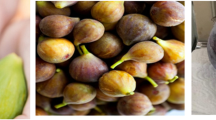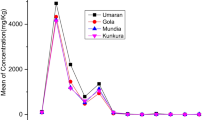Abstract
An analytical study was carried out on the presence of antioxidant constituents and the in vitro antioxidant capacity in the extracts of three species of Spanish red-skinned cactus pear fruits (Opuntia ficus-indica, Opuntia undulata and Opuntia stricta). The cactus pear fruit extracts were analyzed for determined constituents: ascorbic acid, flavonoids (quercetin, isorhamnetin, myricetin, kaempferol and luteolin), betalains, taurine, total carotenoids and total phenolics. The antioxidant capacity was assessed by means of two different methods: the 2,2′-azinobis(3-ethylbenzothiazoline-6-sulfonic acid) (Trolox equivalent antioxidant capacity) method and the 2,2-diphenyl-1-picrylhydrazyl radical method. Opuntia ficus-indica fruit extract had the strongest antioxidant capacity and taurine content. O. stricta fruits were the richest in ascorbic acid and total phenolics, whereas O. undulata fruits showed the highest carotenoid content. Quercetin and isorhamnetin were the main flavonoids detected. This study provides basic information on the presence of bioactive compounds and antioxidant capacity in extracts of cactus pear fruits, in order to consider these extracts as ingredient for the production of health-promoting food.

Similar content being viewed by others
References
Sáenz C (2000) Processing technologies: an alternative for cactus pear (Opuntia spp.) fruits and cladodes. J Arid Environ 46:209–225
Stintzing FC, Schieber A, Carle R (2001) Phytochemical and nutritional significance of cactus pear. Eur Food Res Technol 212:396–407
Feugang JM, Konarski P, Zou D, Stintzing FC, Zou C (2006) Nutritional and medicinal use of cactus pear (Opuntia spp.) cladodes and fruits. Front Biosci 11:2574–2589
Hernández-Pérez T, Carrillo-López A, Guevara-Lara F, Cruz-Hernández A, Paredes-López O (2005) Biochemical and nutritional characterization of three prickly pear species with different ripening behaviour. Plant Foods Hum Nutr 60:195–200
Castellar MR, Obón JM, Fernández-López JA (2006) The isolation and properties of a concentrated red-purple betacyanin food colourant from Opuntia stricta fruits. J Sci Food Agric 86:122–128
Moßhammer MR, Stintzing FC, Carle R (2006) Evaluation of different methods for the production of juice concentrates and fruit powders from cactus pear. Innovat Food Sci Emerg Tech 7:275–287
Tesoriere L, Fazzari M, Allegra M, Livrea MA (2005) Biothiols, taurine, and lipid-soluble antioxidants in the edible pulp of Sicilian cactus pear (Opuntia ficus-indica) fruits and changes of bioactive juice components upon industrial processing. J Agric Food Chem 53:7851–7855
Arcoleo A, Ruccia M, Cusmano S (1961) Sui pigmenti flavonici delle Opuntiae. Nota 1. Isoramnetina dai fiori di O. ficus-indica Mill. Ann Chim 51:751–758
Galati EM, Mondello MR, Giuffrida D, Dugo G, Miceli N, Pergolizzi S, Taviano MF (2003) Chemical characterization and biological effects of Sicilian Opuntia ficus-indica (L.) Mill. fruit juice: antioxidant and antiulcerogenic activity. J Agric Food Chem 51:4903–4908
Kuti JO (2004) Antioxidant compounds from four Opuntia cactus pear fruit varieties. Food Chem 85:527–533
Santos-Buelga C, Scalbert A (2000) Proanthocyanidins and tannin-like compounds: nature, occurrence, dietary intake and effects on nutrition and health. J Sci Food Agric 80:1094–1117
Manach C, Scalbert A, Morand C, Remesy C, Jiménez L (2004) Polyphenols: food sources and bioavailability. Am J Clin Nutr 79:727–747
Chávez-Santoscoy RA, Gutiérrez-Uribe JA, Serna-Saldívar SO (2009) Phenolic composition, antioxidant capacity and in vitro cancer cell cytotoxicity of nine prickly pear (Opuntia spp.) juices. Plant Foods Hum Nutr 64:146–152
Zulueta A, Esteve MJ, Frígola A (2009) ORAC and TEAC assays comparison to measure the antioxidant capacity of food products. Food Chem 114:310–316
Rice-Evans CA, Miller NJ, Papanga G (1997) Antioxidant properties of phenolic compounds. Trends Plant Sci 2:152–159
Fernández-López JA, Castellar R, Obón JM, Almela L (2002) Screening and mass-spectral confirmation of betalains in cactus pears. Chromatographia 56:591–595
Fernández-López JA, Castellar R, Obón JM, Almela L (2007) Monitoring by liquid chromatography coupled to mass spectrometry the impact of pH and temperature on the pigment pattern of cactus pear fruit extracts. J Chromatogr Sci 45:120–125
Castellar R, Obón JM, Alacid M, Fernández-López JA (2003) Color properties and stability of betacyanins from Opuntia fruits. J Agric Food Chem 51:2772–2776
Obón JM, Castellar MR, Alacid M, Fernández-López JA (2009) Production of a red-purple food colorant from Opuntia stricta fruits by spray drying and its application in food model systems. J Food Eng 90:471–479
Singh J, Upadhyay AK, Prasad K, Bahadur A, Rai M (2007) Variability of carotenes, vitamin C, E and phenolics in Brassica vegetables. J Food Compos Anal 20:106–112
Rodríguez-Amaya DB (2001) A guide to carotenoid analysis in foods. ILSI Human Nutrition Institute Press, Washington DC
Obón JM, Castellar R, Cascales JA, Fernández-López JA (2005) Assessment of the TEAC method for determining the antioxidant capacity of synthetic red food colorants. Food Res Int 38:843–845
Brand-Williams W, Cuvelier ME, Berset C (1995) Use of a free radical method to evaluate antioxidant activity. Lebens Wiss Technol 28:25–30
Díaz-Medina EM, Rodríguez-Rodríguez EM, Díaz-Romero C (2007) Chemical characterization of Opuntia dillenii and Opuntia ficus-indica fruits. Food Chem 103:38–45
Gil MI, Tomás-Barberán FA, Hess-Pierce B, Kader AA (2002) Antioxidant capacities, phenolic compounds, carotenoids and vitamin C contents of nectarine, peach, and plum cultivars from California. J Agric Food Chem 50:4976–4982
O’Neill ME, Carroll Y, Corridan B, Olmedilla B, Granado F, Blanco I, Van der Berg H, Hininger I, Rousell AM, Chopra M, Southon S, Thurnham DI (2001) A European carotenoid database to assess carotenoid intakes and its use in a five country comparative study. Br J Nutr 85:499–507
Rao AV, Rao LG (2007) Carotenoids and human health. Pharmacol Res 55:207–216
Miean KH, Mohamed S (2001) Flavonoid (myricetin, quercetin, kaempferol, luteolin and apigenin) content of edible tropical plants. J Agric Food Chem 49:3106–3112
Stintzing FC, Herbach KM, Mosshammer MR, Carle R, Yi W, Sellappan S, Akoh CC, Bunch R, Felker P (2005) Color, betalain pattern, and antioxidant properties of cactus pear (Opuntia spp.) clones. J Agric Food Chem 53:442–451
Tomás-Barberán FA, Gil MI, Cremin P, Waterhouse AI, Hess-Pierce B, Kader AA (2001) HPLC-DAD-ESI/MS analysis of phenolic compounds in nectarines, peaches and plums. J Agric Food Chem 49:4748–4760
Toor RK, Savage GP (2005) Antioxidant activity in different fractions of tomatoes. Food Res Int 38:487–494
Wójcik OP, Koenig KL, Zeleniuch-Jacquote A, Costa M, Chen Y (2010) The potential protective effects of taurine on coronary heart disease. Atherosclerosis 208:19–25
Stintzing FC, Schieber A, Carle R (1999) Amino acid composition and betaxantin formation in fruits from Opuntia ficus-indica. Planta Med 65:632–635
Prior RL, Wu X, Schaich K (2005) Standardized methods for the determination of antioxidant capacity and phenolics in foods and dietary supplements. J Agric Food Chem 53:4290–4302
Butera D, Tesoriere L, Di Gaudio F, Bongiorno A, Allegra M, Pintaudi AM, Kohen R, Livrea MA (2002) Antioxidant activities of Sicilian prickly pear (Opuntia ficus-indica) fruit extracts and reducing properties of its betalains: betanin and indicaxanthin. J Agric Food Chem 50:6895–6901
Piga A, Del Caro A, Pinna I, Agabbio M (2003) Changes in ascorbic acid, polyphenol content and antioxidant activity in minimally processed cactus pear fruits. Lebensm Wiss Technol 36:257–262
Kugler F, Stintzing FC, Carle R (2007) Evaluation of the antioxidant capacity of betalainic fruits and vegetables. J Appl Bot Food Qual 81:69–76
Acknowledgements
This work was financially supported from the Department of Education and Science (MEC) of Spain, project AGL2004-01871. Valuable suggestions made by the reviewers are acknowledged.
Author information
Authors and Affiliations
Corresponding author
Rights and permissions
About this article
Cite this article
Fernández-López, J.A., Almela, L., Obón, J.M. et al. Determination of Antioxidant Constituents in Cactus Pear Fruits. Plant Foods Hum Nutr 65, 253–259 (2010). https://doi.org/10.1007/s11130-010-0189-x
Published:
Issue Date:
DOI: https://doi.org/10.1007/s11130-010-0189-x




